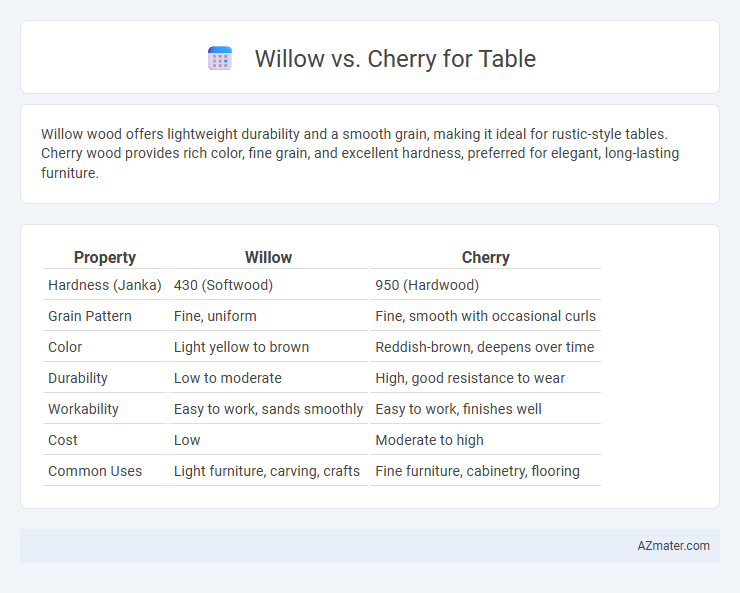Willow wood offers lightweight durability and a smooth grain, making it ideal for rustic-style tables. Cherry wood provides rich color, fine grain, and excellent hardness, preferred for elegant, long-lasting furniture.
Table of Comparison
| Property | Willow | Cherry |
|---|---|---|
| Hardness (Janka) | 430 (Softwood) | 950 (Hardwood) |
| Grain Pattern | Fine, uniform | Fine, smooth with occasional curls |
| Color | Light yellow to brown | Reddish-brown, deepens over time |
| Durability | Low to moderate | High, good resistance to wear |
| Workability | Easy to work, sands smoothly | Easy to work, finishes well |
| Cost | Low | Moderate to high |
| Common Uses | Light furniture, carving, crafts | Fine furniture, cabinetry, flooring |
Overview of Willow vs Cherry Wood
Willow wood is lightweight and flexible with a fine, uniform texture, making it ideal for rustic or artisanal tables, while cherry wood is denser, heavier, and prized for its rich reddish-brown color and smooth grain, offering a more refined, elegant finish. Cherry wood also hardens with age and exposure, enhancing durability and deepening its warm tones, whereas willow remains softer and is more prone to dents and scratches. Willow is generally more affordable and easier to work with, while cherry demands higher craftsmanship but provides superior longevity and aesthetic appeal in table construction.
Key Differences Between Willow and Cherry
Willow wood is lightweight, with a pale, creamy color and a distinct grain pattern, making it ideal for rustic or casual table designs, while cherry wood is denser, featuring a rich reddish-brown hue that deepens with age and offers a smooth, fine grain suitable for formal or elegant tables. Willow is more pliable but less durable than cherry, which is hard and resistant to wear, providing greater longevity for heavily used tabletops. Cost-wise, cherry tends to be more expensive due to its strength and aesthetic appeal, whereas willow offers a budget-friendly option with a unique, natural texture.
Appearance and Grain Patterns
Willow wood features a light, creamy color with subtle, straight grain patterns that provide a smooth, uniform appearance ideal for modern and minimalist tables. Cherry wood exhibits a rich, reddish-brown hue that deepens over time, showcasing distinctive, wavy grain patterns with occasional swirls and fine pores, adding warmth and character to classic or rustic tables. Both woods offer unique aesthetic qualities, with willow emphasizing simplicity and cherry highlighting elegance through dynamic textures.
Durability and Hardness Comparison
Willow wood is softer and less durable compared to cherry, making it more prone to dents and scratches in table construction. Cherry wood boasts a hardness rating of approximately 2.5 on the Janka scale, while willow is significantly lower, typically around 1.0 to 1.5. For long-lasting tables requiring resistance to wear, cherry provides superior durability and hardness.
Workability for Table Making
Willow wood offers excellent workability for table making due to its lightweight nature and easy-to-cut grain, allowing for smooth shaping and carving. Cherry wood, known for its fine and straight grain, provides superior sanding and a natural polish that enhances the table's finish. Both woods are durable, but cherry's denser structure offers improved resistance to dents and scratches compared to willow.
Cost and Availability
Willow wood is generally more affordable than cherry, making it a budget-friendly option for table construction. Cherry wood, known for its rich color and fine grain, tends to be pricier due to its slower growth and higher demand. Both woods are widely available in most lumberyards, but cherry can be harder to find in large quantities or specific grades, potentially affecting overall availability for table projects.
Maintenance and Longevity
Willow wood requires minimal maintenance as it naturally resists warping and moisture, making it suitable for indoor tables with occasional cleaning. Cherry wood demands regular care, including polishing and protection from direct sunlight, to preserve its rich color and prevent surface damage over time. In terms of longevity, cherry wood tables often outlast willow due to their denser grain and greater durability under frequent use.
Environmental Impact and Sustainability
Willow wood offers a lower environmental impact due to its rapid growth rate and ability to regenerate quickly, making it a highly sustainable choice for tables. Cherry wood, while prized for its durability and rich color, grows slower and requires more resources, leading to a larger carbon footprint. Choosing willow supports sustainable forestry practices by reducing habitat disruption and promoting faster carbon sequestration cycles.
Best Uses for Each Wood Type
Willow wood, known for its lightweight and flexible properties, excels in crafting rustic tables and decorative furniture that require easy shaping and a natural aesthetic. Cherry wood offers superior durability and rich, warm tones, making it ideal for high-end dining tables and heirloom pieces that benefit from its strength and elegant aging. Each wood type suits distinct purposes: willow thrives in casual, artistic designs while cherry is preferred for formal, long-lasting furniture.
Choosing the Right Wood for Your Table
Willow wood offers a lightweight and flexible option for tables, known for its unique grain patterns and resistance to cracking, ideal for rustic or artistic designs. Cherry wood provides durability and a rich, warm color that deepens with age, making it excellent for classic, elegant tables requiring strength and longevity. Selecting between willow and cherry depends on whether you prioritize aesthetic warmth and sturdiness or lightweight design with distinctive grain.

Infographic: Willow vs Cherry for Table
 azmater.com
azmater.com